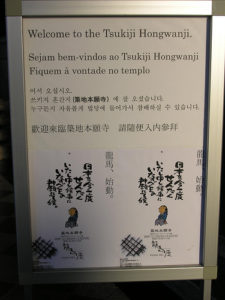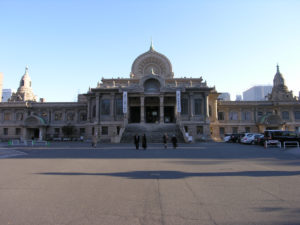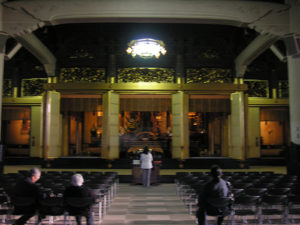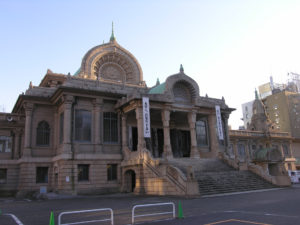Last December, a few days before Christmas, while I was planning the itinerary for my one-day stop in Tokyo, I knew I had to be extremely selective about the places to be visited within the few hours I had at my disposal. Apart from my friends’ suggestions of the regular tourist fare consisting of the traditional Asakusa, the geeky Akihabara, the glitzy Ginza and Roppongi, I had included University of Tokyo in the list. Finally, a few days before flying out, I picked up one of the numerous travel books on Japan during a regular stop at the Borders in Sunnyvale..nonchalantly flipping through it’s pages, landed on the page talking about Tsukiji – the famous Fish Market in Tokyo. I had little time to see a fish market within my tightly packed schedule..but one thing in that book caught my attention. It was the Tsukiji Honganji – the only Indian-style Buddhist Temple in Japan – situated in Tsukiji, and not far from this famous market. I knew I could not miss this.
 It was close to 5pm by the time I made it to Tsukiji Hoganji that day. The metro was overflowing with people returning from work (i guess the salarymen were probably heading towards drinking bars rather than home).
It was close to 5pm by the time I made it to Tsukiji Hoganji that day. The metro was overflowing with people returning from work (i guess the salarymen were probably heading towards drinking bars rather than home).
Locating the temple after exiting from the subway station was not the easiest thing, but ‘Sumimasen..Tsukiji Honganji wa doko desho ka?’ (Excuse me..which way is Tsukiji Hongaji?) helped me get to the place. Once within the premises, it was evident that the complex was endowed with an amount of space quite atypical of the crowded Tokyo. And yes, the structure had a distinctly Hindu architecture, the design of the stone exterior combining Buddhist, Hindu and Islamic architectural styles in a complex manner.
Tsukiji Honganji is a branch of Nishi Honganji Temple in Kyoto; ‘Hongan’ means the ‘long-cherished wish’. ‘Tsukiji’ comes from the kanji characters meaning “reclaimed land” . The temple symbolizes the Indian source of Japanese Buddhism.

The original Tsukiji Honganji Temple, with an Indian-style exterior, was built in 1617 near Asakusa, but was burnt down in a huge fire that swept through Edo (Tokyo) in 1657. The present one was designed by Chūta Ito of the University of Tokyo and built between 1931 and 1934.

After appreciating the exterior, it was time to see the Hon-dō (main hall of worship). This was similar, but larger in size than the Jōdo Shinshū Japanese temples I have seen in San Francisco, Palo Alto, Mountain View and San Jose. While the streets and metro stations of Tsukiji and Ginza areas outside were overflowing with people on the Monday evening, this place presented a peaceful contrast. Nevertheless, there was a continuous stream of people coming in.
Some of the people I observed among them:
- A young couple, who seemed to bring their newborn baby
- An elderly salaryman dressed immaculately and had a string of beads in his palm. He clasped his hands together and prayed. Had a very disciplined demeanor about him, and I wouldn’t be surprised if he was a President of some company or a high-ranking government official.
- A college-going student with a backpack and a punk hairstyle. He bowed before the diety for quite a few seconds.
- A male photographer in his 30s, with long hair tied in a pony tail and a moustache (uncommon there). After praying, he was busy photographing the interiors with his big SLR camera.
I spent a good 20 minutes there, observing, and taking a very brief respite from an extremely busy day, before heading to my next (and completely contrasting) destinations for that evening – Ginza and Roppongi Hills.

Kiran Vaka has a multi-cultural background, and has lived in India and America. His childhood was spent in the cities of Delhi and Bangalore, both of which differ culturally and linguistically. He came to America as a student, and lived on Long Island, NY before moving to Silicon Valley, CA.
Kiran speaks four languages – Telugu, English, Hindi and Japanese. He believes that his experiences have made him capable of being able to easily adapt to any place in the world. He also has a background in Computer Science, where he works on software development and project management, specializing in Customer Relationship Management (CRM) software. He was also the recipient of the DMI Innovator Award from Carnegie Mellon Silicon Valley and NASA Ames in March 2010.









